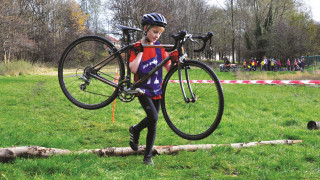Cyclo-cross is one of the fastest growing cycling disciplines with more and more people appreciating the eclectic blend of skills needed to succeed and the variety of terrain encountered.
Here, Go-Ride Coach for Yorkshire, Chris Young - who is a former professional cyclist and cyclo-cross enthusiast - provides his top tips for both riders and coaches at clubs.
I always say get fit for purpose, so if you want to get better at cyclo-cross, train for cyclo-cross. This means practicing over and over all the little skills that you perform during the race, making marginal gains in lots of areas. When you put all the little things together, it adds up to a better performance in a race.
Get a quick start
In order to get a quick start, make sure you are in the right gear, with one foot on the ground, and then hit the pedal and clip in quick, before accelerating and moving through the gears.
Coaches can assist riders with developing this important skill, by timing the riders to go across a set distance, or challenging them by matching them with other riders of similar ability. During rider development sessions, I set the riders off in waves of advanced, intermediate and novice riders.
Mounting and dismounting
Obstacles on the cyclo-cross course force riders to dismount, remount and sometimes carry their bike. Successful mounting and dismounting of the bike is all about conserving momentum, so avoid grinding to a halt and make sure you can dismount at good running speed and get back on at the same pace. This is a skill that needs to be practiced; there are many techniques such as the step-back or step-through, but it is about finding what works for you, then learning to do it quickly.
Coaches should look out for a smooth transition, in dismounting from saddle to feet on the floor, but also from running to being back in the saddle, getting their feet on the pedals then back up to speed. You might need to show by example.
When carrying your bike, practice picking the bike up, moving with it comfortably, and sometimes putting it on the shoulder. However, some bikes have a smaller inner triangle and, with the addition of bottle cages, mean shouldering may not be appropriate. Additionally, coaches should look out for the riders looking comfortable and balanced, making sure they can put the bike down and get back on it quickly.
Mastering hills: ascending and descending
Practice going up and down hills on a variety of surfaces. Get comfy with shifting your weight around the bike to keep your weight centred, depending on whether you are going up or downhill. Learn to relax on the bike and be relaxed in your braking by practicing feathering (lighter, more frequent touches of the brakes).
Coaches can look out for the riders being relaxed, not grabbing brakes too hard, and look out for them using their gears correctly. Do they look like they are in the right gears for going up or down hill?
Cornering
Cyclo-cross takes place on a variety of surfaces, which means cornering technique can vary. Pick a line that has the most traction and that allows you to keep your speed, which can be applied to any surface. Additionally, coaches should educate riders on what to expect should the surface change from mud to grass, or gravel to concrete and how to handle the bike on these surfaces.
British Cycling delivers discipline-specific Level 2 awards for coaches who would like to develop an in-depth understanding of cyclo-cross. For more information, visit www.britishcycling.org.uk/coaching





